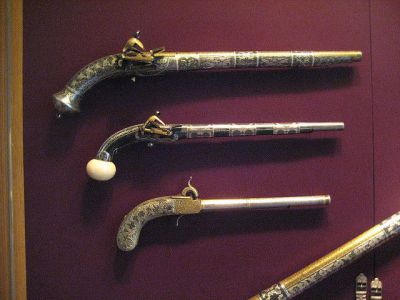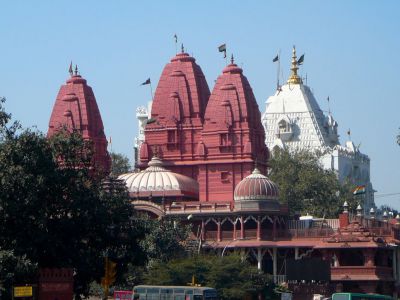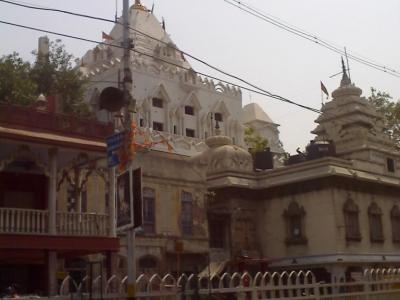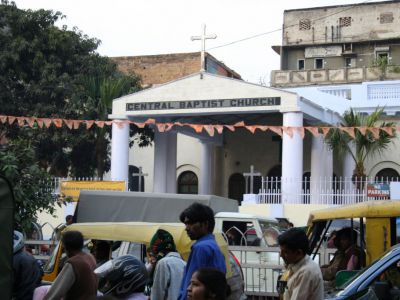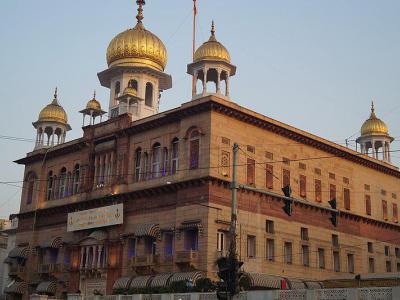Custom Walk in Delhi, India by emurphy_acf9d created on 2025-05-08
Guide Location: India » Delhi
Guide Type: Custom Walk
# of Sights: 5
Tour Duration: 1 Hour(s)
Travel Distance: 1.4 Km or 0.9 Miles
Share Key: BDQAX
Guide Type: Custom Walk
# of Sights: 5
Tour Duration: 1 Hour(s)
Travel Distance: 1.4 Km or 0.9 Miles
Share Key: BDQAX
How It Works
Please retrieve this walk in the GPSmyCity app. Once done, the app will guide you from one tour stop to the next as if you had a personal tour guide. If you created the walk on this website or come to the page via a link, please follow the instructions below to retrieve the walk in the app.
Retrieve This Walk in App
Step 1. Download the app "GPSmyCity: Walks in 1K+ Cities" on Apple App Store or Google Play Store.
Step 2. In the GPSmyCity app, download(or launch) the guide "Delhi Map and Walking Tours".
Step 3. Tap the menu button located at upper right corner of the "Walks" screen and select "Retrieve custom walk". Enter the share key: BDQAX
1) Swatantrata Sangram Sanghrahalya
Swatantrata Sangram Sanghrahalya also known as the museum of Independence movement is located within the premises of Red Fort, New Delhi. If you enter the fort through the Lahore gate, you can reach this museum with ease. The museum represents significant features of Indian Independence movement such as the Sepoy Mutiny in 1857, the first battle of independence and Quit India Movement.
The Red Fort was occupied by the British Army after the Mughal rule. You will learn all significant details about this important piece of history here. In the Sanghrahalya, you will find a vivid depiction of freedom struggle through paintings, documents, photographs and lithographs. Also on display are guns, swords and pistols used during the struggle. Medals, shields, sculptures and dioramas are other important objects to be seen at this museum. The museum provides you with a clear idea of how the Indian freedom fighters gained confidence and opposed the mighty British army. You will be inspired by the pictures of great freedom movement leaders.
The museum is open between 9 Am and 5 PM on all days except Monday. The entry fee is included in the Red Fort fee of Rs. 11 for Indians and Rs.100 for foreigners.
The Red Fort was occupied by the British Army after the Mughal rule. You will learn all significant details about this important piece of history here. In the Sanghrahalya, you will find a vivid depiction of freedom struggle through paintings, documents, photographs and lithographs. Also on display are guns, swords and pistols used during the struggle. Medals, shields, sculptures and dioramas are other important objects to be seen at this museum. The museum provides you with a clear idea of how the Indian freedom fighters gained confidence and opposed the mighty British army. You will be inspired by the pictures of great freedom movement leaders.
The museum is open between 9 Am and 5 PM on all days except Monday. The entry fee is included in the Red Fort fee of Rs. 11 for Indians and Rs.100 for foreigners.
2) Sri Digambar Jain Lal Mandir
Situated opposite Red Fort in Delhi, Digambar Jain Lal Mandir was originally built in 1526 during the reign of Mughal Emperor Jahangir. This temple has since undergone various modifications. The temple was constructed without the Shikara as the Mughal Emperor did not permit its construction. The shikaras were added on only after India obtained independence. The main deity of this temple is Tirthankara Parashvanath. The temple is famous for its fine carvings and decorative paint-works.
Once you enter the temple, the Manastambha column will welcome you. The main prayer hall is located in the first floor of the temple. You must first cross a small courtyard, which is encircled by an arcade. Apart from the main shrine dedicated to Tirthankara, there are many other shrines. One of the important shrines is the one dedicated to Lord Adinath. The temple is known for its soothing ambiance. Pilgrims and tourists flock here to enjoy its calm atmosphere. The divine aura is enhanced with candle lights and butter lamps. The walls of the shrine are decorated with glided paintwork.
You can find a bookstore with a huge collection of books inside the temple. Paryushan, Deepawali and Jnaan Panchami are the important festivals observed here. There is a Bird’s hospital inside the temple, which contains separate wards for parrots, pigeons, sparrows and domestic fowl.
Once you enter the temple, the Manastambha column will welcome you. The main prayer hall is located in the first floor of the temple. You must first cross a small courtyard, which is encircled by an arcade. Apart from the main shrine dedicated to Tirthankara, there are many other shrines. One of the important shrines is the one dedicated to Lord Adinath. The temple is known for its soothing ambiance. Pilgrims and tourists flock here to enjoy its calm atmosphere. The divine aura is enhanced with candle lights and butter lamps. The walls of the shrine are decorated with glided paintwork.
You can find a bookstore with a huge collection of books inside the temple. Paryushan, Deepawali and Jnaan Panchami are the important festivals observed here. There is a Bird’s hospital inside the temple, which contains separate wards for parrots, pigeons, sparrows and domestic fowl.
3) Gauri Shankar Temple
This temple is located on Chandni Chowk road in Delhi and is one of the most noteworthy temples for devoted to Lord Shiva. It houses an 800 year old lord Shiva’s manifestation-Lingam. The lingam is surrounded by snakes made of silver. A water vessel made of silver is placed above the lingam, from which water drops fall over it continuously.
According to legends, Apa Gangadhar, a devotee of Shiva was badly injured in a battle. His chance of survival was very low. He prayed to God and promised that he would build a Shiva temple, if he survives. Gangadhar survived and he built this temple to show his gratitude to the lord for saving his life. You can see his name inscribed at the end of the spire near the entrance.
The idols of Lord Shiva, his wife Parvati and his two sons, Ganesh and Kartik are housed in the temple. The life of Shiva is beautifully narrated on the walls of the temple. The most important attraction of this temple is the marble chair of a Hindu saint named Bhagat Swaroop Bramhachari, who spent most of his life in the temple. His teachings, portrait and sandals are preserved in this temple. Monday is the most auspicious day to visit the temple.
According to legends, Apa Gangadhar, a devotee of Shiva was badly injured in a battle. His chance of survival was very low. He prayed to God and promised that he would build a Shiva temple, if he survives. Gangadhar survived and he built this temple to show his gratitude to the lord for saving his life. You can see his name inscribed at the end of the spire near the entrance.
The idols of Lord Shiva, his wife Parvati and his two sons, Ganesh and Kartik are housed in the temple. The life of Shiva is beautifully narrated on the walls of the temple. The most important attraction of this temple is the marble chair of a Hindu saint named Bhagat Swaroop Bramhachari, who spent most of his life in the temple. His teachings, portrait and sandals are preserved in this temple. Monday is the most auspicious day to visit the temple.
4) Central Baptist Church
Located on the Chandni Chowk Road, Delhi, Central Baptist Church is the oldest mission church in North India. It was built by the Baptist Missionary Society, London in 18th century. The church stands as a fine exemplar of European style architecture. The walls of the church boast of memorial tablets, which specify the names of the people who served the church dedicatedly.
The church is open on all days, but the best time to visit is on Sundays and/or at the time of their annual event. The Central Baptist Church is thronged by devotees every Sunday. The choir members sing church hymns and prayer songs. The church is decorated beautifully during the annual event. The vivid and colorful decor and lights create the festival mood. The church organizes many cultural programs through the year.
This well preserved church attracts devotees and tourists alike. The colorful designs and fine carvings enhance the elegant appearance of the exterior. The roof of the church was renovated later with stones, shafts and iron beams. The church has a large deep porch, which is supported by thick circular columns on the southern side. It also houses a primary school, where Baptist community children are given first preference. However, it also accepts children from other communities.
The church is open on all days, but the best time to visit is on Sundays and/or at the time of their annual event. The Central Baptist Church is thronged by devotees every Sunday. The choir members sing church hymns and prayer songs. The church is decorated beautifully during the annual event. The vivid and colorful decor and lights create the festival mood. The church organizes many cultural programs through the year.
This well preserved church attracts devotees and tourists alike. The colorful designs and fine carvings enhance the elegant appearance of the exterior. The roof of the church was renovated later with stones, shafts and iron beams. The church has a large deep porch, which is supported by thick circular columns on the southern side. It also houses a primary school, where Baptist community children are given first preference. However, it also accepts children from other communities.
5) Gurudwara Sis Ganj Sahib
Situated in Old Delhi's Chandni Chowk, Gurudwara Sis Ganj Sahib was established in 1783 by Baghel Singh as a tribute to the Sikh Guru, Tegh Bahadur. Tegh Bahadur was tragically executed under the orders of the Mughal emperor, Aurangzeb, as he vehemently opposed the forced conversion of Kashmiri Pandits and other dharmic individuals to Islam. The Gurudwara was later constructed on the site of his martyrdom. Another significant historical event at this sacred place was when Guru Gobind Singh visited in 1702.
Within the shrine, visitors can see the preserved trunk of the tree where Guru Tegh Bahadur's head was severed, as well as the well he used during his imprisonment for bathing. Adjacent to the Gurudwara stands the Kotwali (police station) where Guru Tegh Bahadur was held captive and his disciples were subjected to torture before their execution.
An unmissable attraction near the Gurudwara is the museum on the opposite side, offering insight into the captivating history that makes for an intriguing story to share with the kids. The museum is named after Bhai Mati Das, Bhai Sati Das, and Bhai Dyal Das, who were devout followers of Guru Tegh Bahadur and also faced execution by Aurangzeb's decree.
Why You Should Visit:
Smaller than Bangla Sahib, this is another beautiful and peaceful gurudwara where everyone is welcome. It is also very colorful.
Tip:
Be sure to peek into the kitchen & serving area (right opposite the very clean toilets behind the main building), where anyone regardless of faith is served a vegetarian meal, as in all gurudwaras.
Within the shrine, visitors can see the preserved trunk of the tree where Guru Tegh Bahadur's head was severed, as well as the well he used during his imprisonment for bathing. Adjacent to the Gurudwara stands the Kotwali (police station) where Guru Tegh Bahadur was held captive and his disciples were subjected to torture before their execution.
An unmissable attraction near the Gurudwara is the museum on the opposite side, offering insight into the captivating history that makes for an intriguing story to share with the kids. The museum is named after Bhai Mati Das, Bhai Sati Das, and Bhai Dyal Das, who were devout followers of Guru Tegh Bahadur and also faced execution by Aurangzeb's decree.
Why You Should Visit:
Smaller than Bangla Sahib, this is another beautiful and peaceful gurudwara where everyone is welcome. It is also very colorful.
Tip:
Be sure to peek into the kitchen & serving area (right opposite the very clean toilets behind the main building), where anyone regardless of faith is served a vegetarian meal, as in all gurudwaras.
